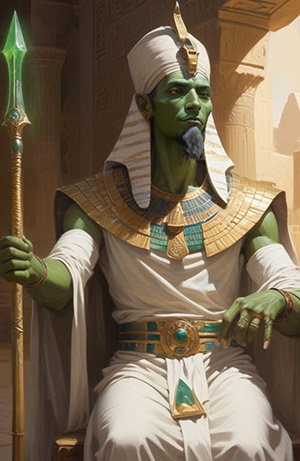Ptah is a mysterious creator deity, and said to be the god of craftsmen and architects. Legends suggest that Ptah existed before even Re and Apep, and that he may have created them—and even other gods in other pantheons. True believers in Ptah even say that Ptah existed before all other things and, by his will, thought the world into existence.
He bears many epithets including: Ptah the beautiful face, lord of truth, master of justice, who listens to prayers, master of ceremonies and Ptah lord of eternity.
As god of craftsmen, the cult of the god Ptah quickly spread throughout Egypt. With the major royal projects of the Old Kingdom, the high priests of Ptah were particularly sought after and worked in concert with the vizier, filling the role of chief architects and master craftsmen, responsible for the decoration of the royal funerary complexes.
His priests defy common Pharaonic practice by wearing black vestments adorned with glittering white stars, though males still shave their heads in accordance with tradition. They emulate their deity by exercising their god-given creativity in arts or crafts, traveling widely, and striving to maintain order. Ptah has both male and female clerics.
Ptah's temples tend to be small but elaborate structures, usually built in remote locations. Their ceilings are commonly decorated with images of the night sky full of stars.
Ptah's law is the order of the universe. Everything has a place in the cosmic scheme, and everything fits together to work for a purpose that is beyond mortal understanding. Ptah may have set this intricate cosmic machinery in motion, and it seems quite likely that he is the only one who knows its purpose or eventual result. His followers generally act as though they're in on the secret, but certainly none of them know as much as Ptah himself. Mortals can simply do their best to fill the part they're supposed to play, not overstepping their place or spreading disorder in the well-ordered world.
Ptah has appeared in several forms, sometimes appearing as a small man with black skin like polished marble and large black eyes filled with stars.
Other times, Ptah appears in the guise of a man with green skin, contained in a shroud sticking to the skin, wearing the divine beard, and holding a scepter combining three powerful symbols of ancient Egyptian religion: The Was sceptre, The sign of life (Ankh), and the Djed pillar. These three combined symbols indicate the three creative powers of the god: power (was), life (ankh) and stability (djed).
Ptah has also been represented as a dwarf, naked and deformed.
Ptah is related to the rest of the Pharaonic pantheon only by marriage (to Re-Horakhty's daughter Bast), not by birth. Despite his marriage to Bast, he remains aloof from the struggles and rivalries of the Pharaonic pantheon, spending his time wandering the vast expanses of the planes.

